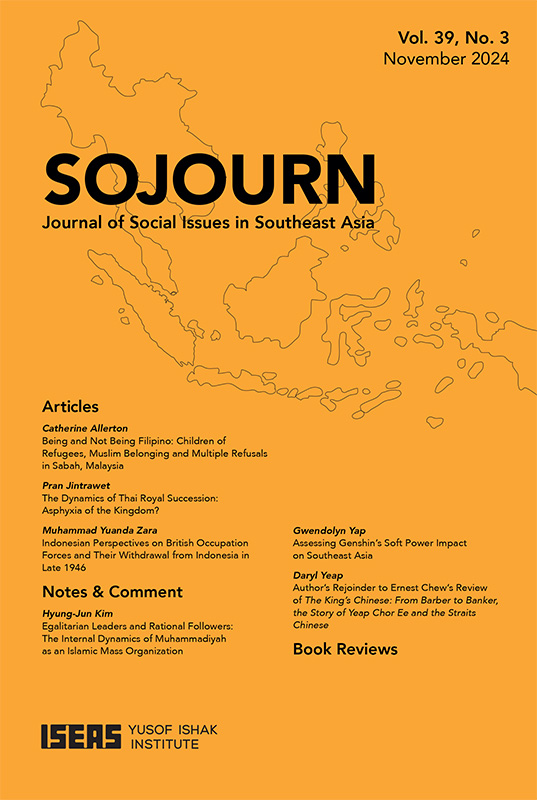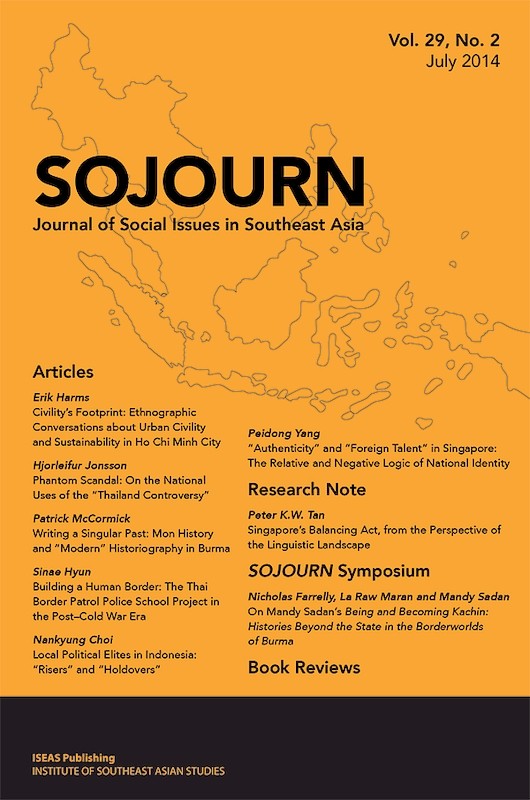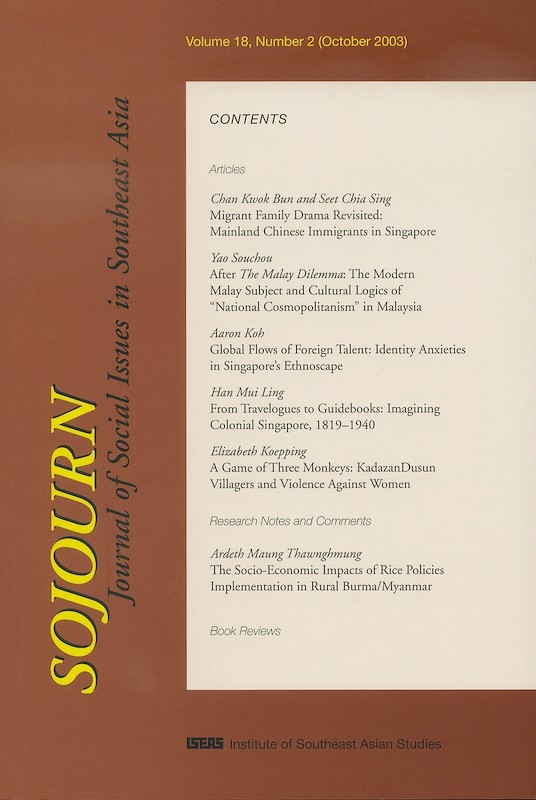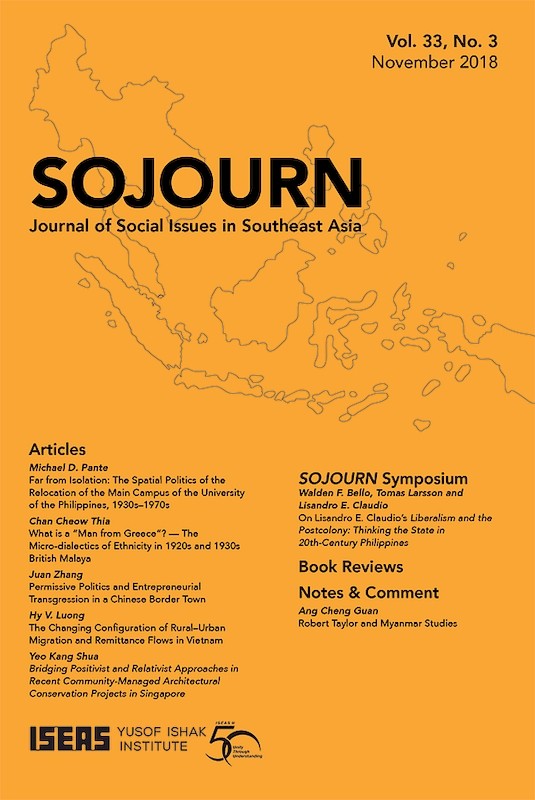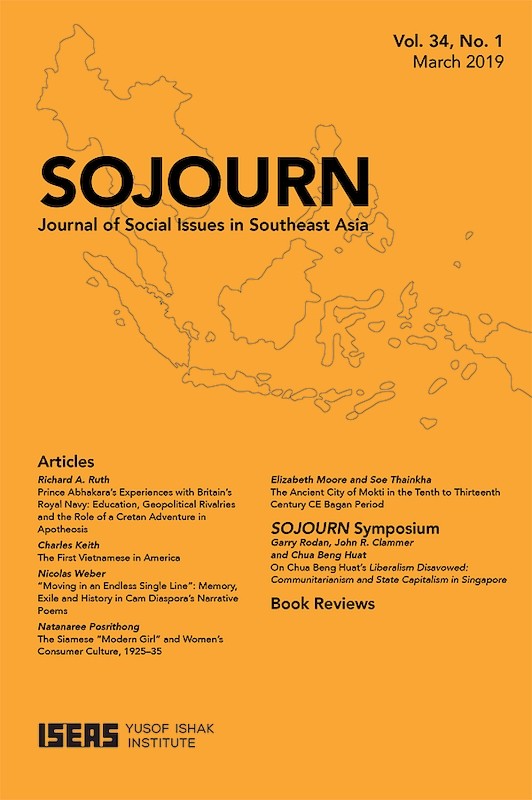SOJOURN: Journal of Social Issues in Southeast Asia Vol. 36/3 (November 2021)
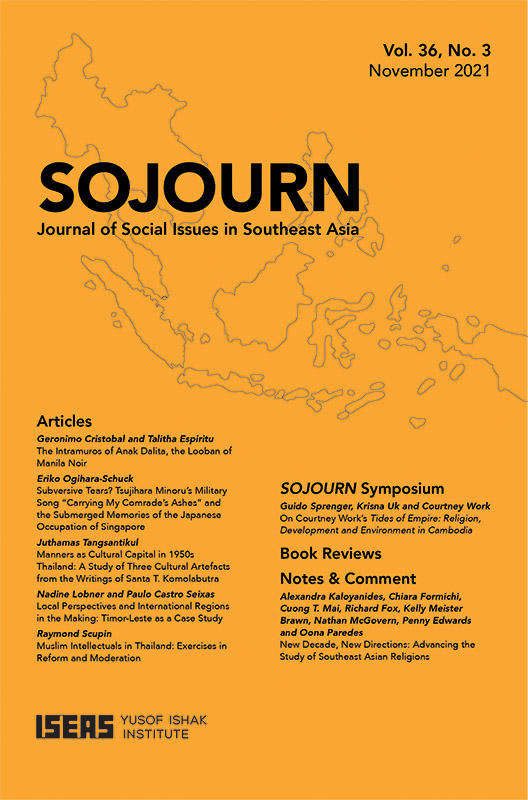
Date of publication:
November 2021
Publisher:
ISEAS – Yusof Ishak Institute
Number of pages:
214
Code:
SJ36/3
Contents
-
SOJOURN: Journal of Social Issues in Southeast Asia Vol. 36/3 (November 2021)
[Whole Publication, ISSN: 17932858] -
Preliminary pages
- ARTICLES
-
1. The Intramuros of Anak Dalita, the Looban of Manila Noir, by Geronimo Cristobal, Talitha Espiritu, authors see abstractThis article examines Lamberto Avellana’s Anak Dalita (LVN Pictures, 1956) as a crime melodrama that places Intramuros, Manila’s historic walled city, within the cinematic urban geography of film noir. It probes the film’s representation of the transformation of Intramuros from a colonial city of cathedrals and mansions to a post-war ruin associated with squatters and urban poverty. Situating <i>Anak Dalita</i> within the context of the reconfiguration of Manila’s urban space in the two decades that followed the Second World War, this essay interprets the film’s narrative about a disabled veteran’s quest to regain his self-worth in Intramuros as an allegory of post-war urban rehabilitation. The looban (meaning interior space, interiority and a gathering of wills) is proposed as a conceptual tool to critique<i> Anak Dalita</i>’s solutions to the squatter problem in Intramuros.
-
2. Subversive Tears? Tsujihara Minoru’s Military Song “Carrying My Comrade’s Ashes” and the Submerged Memories of the Japanese Occupation of Singapore, by Eriko Ogihara-Schuck, author see abstract"Sen’yū no ikotsu o daite" (Carrying My Comrade’s Ashes) (1942), a Japanese military song about the fall of Singapore on 15 February 1942, is a subversive text. Written and composed by Japanese soldiers, the song served during the Second World War as a propaganda text celebrating Japanese imperialism, and after the war as an anti-war text promoting post-war pacifism. Both during and after the war, however, the song triggered responses in audiences, often through the act of crying, to reveal the war memories that both imperialist and pacifist ideologies had submerged.
-
3. Manners as Cultural Capital in 1950s Thailand: A Study of Three Cultural Artefacts from the Writings of Santa T. Komolabutra, by Juthamas Tangsantikul, author see abstractThis article is concerned with the study of three manners-related cultural artefacts produced and circulated during the 1950s in Thailand. Together, these artefacts capture, literally and visually, a proposal for ideal manners for the emerging Thai urban middle class. The article argues for the recognition of everyday commodities in the accumulation and display of good manners, emphasizing the moment of unification between the embodied and the objectified states of cultural capital. In so doing, the article highlights the link between manners and consumer capitalism. It also discusses how the imposition of Thai morality on modern consumption was instrumental in effecting politico-economic change in that era.
-
4. Local Perspectives and International Regions in the Making: Timor-Leste as a Case Study, by Nadine Lobner, Paulo Castro Seixas, authors see abstractThis paper is an exploratory exercise in understanding the construction of international regions using anthropological perspectives, with Timor-Leste as a case study. We propose that ‘local beyond-border perspectives’ establish a new domain within the world at large as a representation of transnationalism and globalization ‘from the bottomup’. We discuss this using an interdisciplinary approach—anthropology and international relations—to contribute to the study of international regions through a complementary double-ideological system spanning state relations and local perspectives. We argue that the beyond-border perceptions that people from Timor-Leste have of regional organizations are more appropriately understood as projections of their narratives and aspirations. Such situational flexibility, understood as pragmatic transnationalism, builds upon ancient narratives and inside-outside relations.
-
5. Muslim Intellectuals in Thailand: Exercises in Reform and Moderation, by Raymond Scupin, author see abstractMuslim discourse in Thailand including sensationalist and essentialist conceptions have been circulating widely since the outbreak of violence in South Thailand in 2004. However, Islamic discourse in Thailand is heterogeneous. Islamic reform movements have been contesting the more militant forms of discourse for years. Various Muslim intellectuals operating in early and more contemporary forms of the public sphere have been effective leaders of these reformist campaigns and have had an enormous influence on the Muslim communities in Thailand.
- SOJOURN Symposium
-
On Tides of Empire: Religion, Development and Environment in Cambodia by Courtney Work, by Guido Sprenger, Krisna Uk, Courtney Work, authors
- BOOK REVIEWS
-
BOOK REVIEW: The Complete Lives of Camp People: Colonialism, Fascism, Concentrated Modernity, by Rudolf Mràzek, by Danilyn Rutherford, author
-
BOOK REVIEW: The King’s Chinese: From Barber to Banker, the Story of Yeap Chor Ee and the Straits Chinese, by Daryl Yeap, by Ernest Chew, author
-
BOOK REVIEW: Christian Circulations: Global Christianity and the Local Church in Penang and Singapore, 1819–2000, by Jean DeBernardi, by Jayeel Cornelio, author
-
BOOK REVIEW: One or Two Words: Language and Politics in the Toraja Highlands of Indonesia, by Aurora Donzelli, by Edwin de Jong, author
-
BOOK REVIEW: The Republic of Vietnam, 1955–1975: Vietnamese Perspectives on Nation Building, edited by Tuong Vu and Sean Fear, by Dang Nguyen, author
-
BOOK REVIEW: Demanding Images: Democracy, Mediation, and the Image-Event in Indonesia, by Karen Strassler, by Felicia Hughes-Freeland, author
-
BOOK REVIEW: Mekong Dreaming: Life and Death along a Changing River, by Andrew Alan Johnson, by Ian G Baird, author
- NOTES & COMMENT
-
New Decade, New Directions: Advancing the Study of Southeast Asian Religions, by Alexandra Kaloyanides, Chiara Formichi, Cuong T. Mai, Richard Fox, Kelly Meister Brawn, Nathan McGovern, Scott Edwards, Oona Paredes, authors

